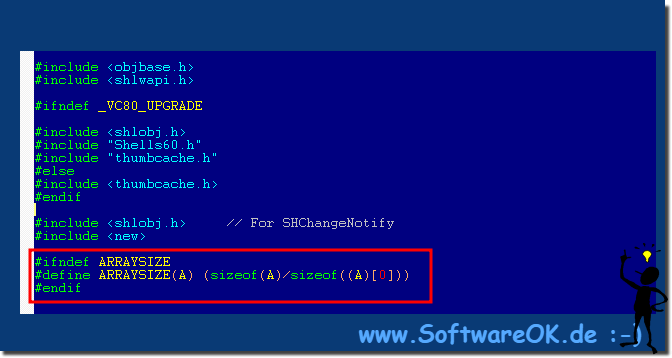It's simple - ARRAYSIZE Error creating, fix error message: : error C2065: 'ARRAYSIZE' : undeclared identifier!
|
| (Image-1) ARRAYSIZE Error when creating, fix it yourself! |
 |
The problem is that the 1989/1990 version of the C standard does not allow mixing declarations and statements within a block. All declarations must appear first, followed by all statements. The 1999 C standard changed this, but Microsoft's C compiler has very little support for post-1990 C standards. I expect that in a future version they may allow mixed declarations and statements, since this is also a C++ feature.
2.) Example with ARRAYSIZE in a small C program!
In this code, we used the ARRAYSIZE macro to determine the size of the array myArray, and then we used a loop to iterate over the elements of the array. The comments explain what each part of the code does.#include <iostream>
// Definition of the ARRAYSIZE macro
#ifndef ARRAYSIZE
#define ARRAYSIZE(A) (sizeof(A) / sizeof((A)[0]))
#endif
int main()
{
// An example integer array
int myArray[] = {1, 2, 3, 4, 5};
// Use the ARRAYSIZE macro to determine the size of the array
int size = ARRAYSIZE(myArray);
// Output the size of the array
std::cout << "The size of the array is: " << size << std::endl;
// Iterate over the array using the determined size
for (int i = 0; i < size; ++i)
{
std::cout << "Element " << i << ": " << myArray[i] << std::endl;
}
return 0;
}
3.) What are the advantages and disadvantages of ARRAYSIZE?
The ARRAYSIZE macro has both advantages and disadvantages:Advantages:
Automatic calculation of array size: ARRAYSIZE allows you to automatically calculate the size of an array without having to set it manually. This makes the code more maintainable because changes in the array size are automatically taken into account.
Avoid hard coding: The macro avoids hard coding constant values, which reduces errors. When you change the size of an array, the code adjusts automatically.
Readability and clarity: Using ARRAYSIZE in the code makes the purpose clearer and helps other developers understand that you need the size of the array.
Disadvantages:
No argument type checking: The macro does not check if the argument passed is actually an array. Accidentally passing a variable or pointer can cause unexpected behavior.
Not for dynamically allocated arrays: The macro does not work for dynamically allocated arrays because they can change their size at runtime. It is only suitable for static arrays.
Compiler dependency: Using sizeof in macros can cause problems when porting the code between different compilers or platforms, as the size calculation of data types can vary.
Alternatives in C: There are better alternatives in C, such as using standard containers like std::vector, which already have built-in sizing and other useful features.
Overall, the ARRAYSIZE macro can be very useful in certain cases, especially in C, to determine the size of static arrays. However, one should be aware of the disadvantages mentioned above and make sure that it is suitable for the specific use case. In modern C, alternative approaches such as using std::vector or range-based for loops are usually preferred.
FAQ 21: Updated on: 4 September 2024 10:18
